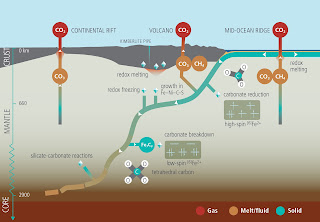Distribute new Discoveries on Carbonate Dissolves in Earth's Mantle
Geologists from Florida State University's Department of Earth, Ocean and Atmospheric Science have found how carbon-rich liquid stone in the Earth's upper mantle may influence the development of seismic waves.
The new examination was coauthored by EOAS Associate Professor of Geology Mainak Mookherjee and postdoctoral scientist Suraj Bajgain.
Discoveries from the examination were distributed in the diary Proceedings of the National Academy of Sciences .

"This exploration is very significant since carbon is an essential constituent for the livability of the planet, and we are gaining ground to see how strong earth may have assumed a job in putting away and affecting the accessibility of carbon in the Earth's surface," Mookherjee said. "Our examination gives us a superior comprehension of the flexibility, thickness and compressibility of these stones and their job in Earth's carbon cycle."
Carbon, one of the essential structure obstructs forever, is generally appropriated all through the Earth's upper mantle and is for the most part put away in types of carbonate minerals as embellishment minerals in mantle rocks. At the point when carbonate-rich magma emits on a superficial level, it is remarkable for its extraordinary, mud-like appearance. These sorts of emissions happen at explicit areas around the globe, for example, at the Ol Doinyo Lengai fountain of liquid magma in Tanzania.
Specialists accept that the nearness of carbonates in rocks fundamentally brings down the temperature at which they soften. Carbonates that sink to the Earth's inside, by means of a procedure known as subduction, likely reason this low-degree softening of the Earth's upper mantle rocks, which assumes a significant job in the planet's profound carbon cycle.
"Earth's mantle has less free oxygen accessible at expanding profundities," Mookherjee said. "As the mantle upwells through a procedure of mantle convection, the gradually moving rocks that were decreased, or had less oxygen, at a more prominent profundity become dynamically more oxidized at shallower profundity. The carbon in the mantle is probably going to be decreased further in the Earth and get oxidized as the mantle upwells."
This adjustment top to bottom ward oxidation state is probably going to cause liquefying of mantle shakes, a procedure called redox dissolving, which could deliver carbon-rich liquid stone, otherwise called liquefies. These melts are probably going to influence the physical property of a stone, which can be recognized utilizing geophysical tests, for example, seismic waves, he said.
Before this investigation, geologists had helpless information on the flexible properties of these carbonate-prompted halfway melts, which made them hard to legitimately identify.
One lot of pieces of information that geologists use to all the more likely comprehend their science are estimations of seismic waves as they travel through the layers of the Earth. A kind of seismic wave known as a compressional wave is quicker than another sort known as a shear wave, however at profundities of around 180 to 330 kilometers into the Earth, the proportion of their velocities is significantly higher than is run of the mill.
"This raised proportion of compressional waves to the shear waves has been a riddle, and utilizing the discoveries from our investigation, we can clarify this confounding perception," Mookherjee said.
Minor amounts of carbon-rich melts, around 0.05 percent, may be scattered unavoidably through the Earth's profound upper mantle, and that may prompt the raised proportion of compressional to shear sound speed, analysts clarified.
To direct the examination, specialists took high-pressure ultrasonic estimations and thickness estimations on centers of the carbonate mineral dolomite. These analyses were supplemented by hypothetical reproductions to give another comprehension of the central physical properties of carbonate liquefies.
"We have been attempting to comprehend the flexible and transport properties of watery liquids, silicate dissolve and metallic soften properties, to increase better understanding into the mass of volatiles put away in the profound strong earth," Bajgain said.
These discoveries mean the somewhat liquid rocks in the mantle could hold as much as 80 to 140 sections for each million of carbon, which would be 20 to 36 million gigatons of carbon in the profound upper mantle locale, making it a significant carbon store. In examination, Earth's climate contains a little more than 410 ppm of carbon, or around 870 gigatons.
Story Source:
Materials gave by Florida State University.
Original composed by Amy Robinson.
Note: Content might be altered for style and length.
Know Subduction Zone
Visit Official Home Page






0 Comments